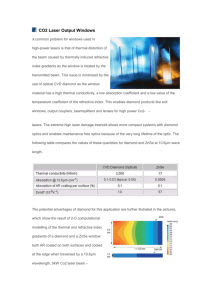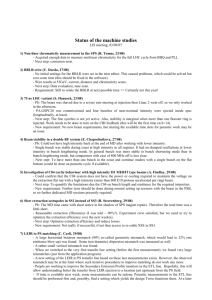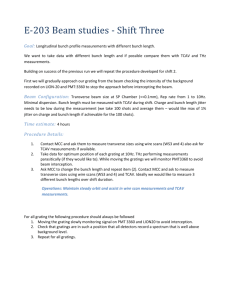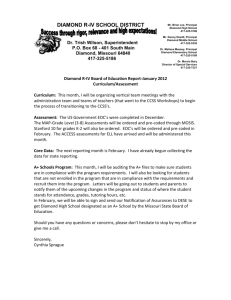LPROT-2
advertisement
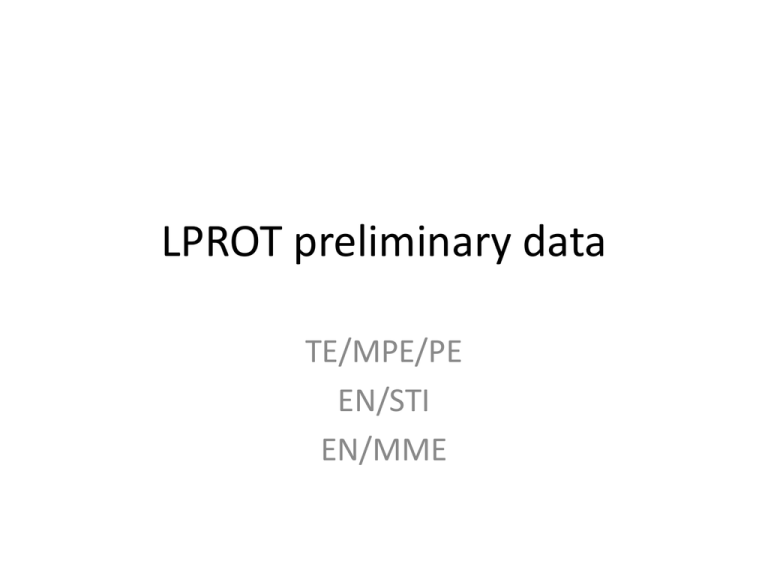
LPROT preliminary data TE/MPE/PE EN/STI EN/MME History • >8 yr ago. Simulations from N. Tahir and CERN pointed that a tunneling process happens when a high-intense high-dense beam interacts with matter. • Verena & Rüdiger experiment at SPS. • Couple of years ago, SPS experiment idea. • Last year, HiRadMat facility experiment request. SPS material test Zinc, stainless steel, copper and INCONEL Verena Kain (2005) Four intensities [SPS-beam type @ 450 GeV 1.1x0.6mm sigma]: 11 12 16 17 A=1.3x1012, B=2.6x1012, C=5.3x1012, D=7.9x1012 The experiment confirms the 5% (2.3e12 p) equipment damage level @ 450GeV 3 Cu plates (simulations predicts plate 18th 1st to melt) Pressure evolution (0.5mm) Location of HiRadMat 5 Layout of Experimental Area Vacuum window Large Large test stand test object 1 2 Small Small test stands objects 3 Beam dump Beam BPM BTV Focal point positions BPKG 2m • Flexible optics to provide beam radii of s = 0.1 to 2.0 mm at the focal points. • Focal point longitudinal location continuously variable between positions 1 and 3. • Predefined optics for 3 focal points and 6 beam sizes. 6 Experiment Experiment • Target assembly done in collaboration with EN/STI • Diamond detectors + associated electronics, designed specifically for this experiment in collaboration with EG (Erich Griesmayer) • Strain gauges in collaboration with EN/MME Installation Installation Phase I (22-Jun/6-Jul), Beam summary • 71 low intensity single bunch shots (2E9-1E10 p+) • 85 high intensity single bunch shots (1E112E11 p+) • 8 high intensity multi-bunch shots (1.5E11 p+) Diamond detector signal 1 bunch low intensity 20dB attenuation Magenta = first diamond detector (z=40cm) Green = second diamond detector (z=50cm) Blue = third diamond detector (z=120cm) Diamond detector linearity Detector signal versus beam intensity Diamond detector linearity • Diamond detectors have a good linearity for a wide intensity range. • Tested different bias voltage across the detectors and its influence on the signal. • Other characteristics also understood and in process of understanding. Diamond FWHM Multi-bunch 6 bunches 40 dB attenuation Intensity=8.47E11p+ Multi-bunch 1.9E11p+ per bunch, 6 bunches. Multi-bunch 12 bunches 40 dB attenuation Intensity=8.32E11p+ Multi-bunch ~1.9E11p+ per bunch, 12 bunches. Multi-bunch • Offset after second bunch of 50mV. Coming from electronics. • No signal pile-up. • No offset pile-up. • Diamond signal linear for every bunch. Photographic paper Photographic paper Photographic paper Photographic paper Strain Gauges SEM detectors SEM detectors Microphones Microphones Microphones Microphones Target 3 Single bunch 4.5E10 protons Beam sound Conclusion • We were ready for phase II. • Refine beam pulse list for phase II (Tuesday 10-July) No 226 227 228 # bunches 144 108 144 Intensity p/bunch 1.50E+11 1.50E+11 1.50E+11 Beam Pulse List Beam spot [mm] Bunch Total Sigma_x Sigma_y spacing [ns] 2.16E+13 2 2 50 1.62E+13 0.2 0.2 50 2.16E+13 0.2 0.2 50 Pulse length [us] target 1 target 2 target 3 Phase II (12-July-2012) • Target 1: 2mm sigma beam (no tunneling expected) -> base shot • Target 3: 0.2mm sigma beam -> tunneling expected Simulations Diamond signal (0.1mm beam sigma) 1.00E-02 9.00E-03 fluence(part/cm2/p+) 8.00E-03 7.00E-03 6.00E-03 300ns 5.00E-03 1500ns 12th 4.00E-03 block 4300ns 6800ns 3.00E-03 5th block 2.00E-03 1.00E-03 4th block 0.00E+00 2.5 17.5 32.5 47.5 62.5 77.5 92.5 107.5 122.5 137.5 152.5 z (cm) Simulations: different beam size, beam intensity, Nbunches, bunch spacing. Analysis of the data 1. Analyze and correct the data from the instrumentation 2. Update simulations with experiment parameters 3. Visual inspection of the target 4. Compare: simulations / data from experiment / visual inspection PRELIMINARY DATA/INTERPRETATION FROM HIRADMAT EXPERIMENT 1. Raw signal Target 1 144 bunches Target 3 144 bunches Microphones Target 3 Single bunch 4.5E10 protons Beam sound Target 3 Single bunch 144 bunches 1.5E11 protons/bunch Beam sound Diamond Detectors Background Au V + + + + + - C (diamond) Au X+ Diamond 1, target 1,3 Diamond 2, target 1 vs 3 Diamond 3, target 1 vs 3 1.A (target 1 – target 3 signal) Diamond 1, target 1 – target 3 Diamond 2, target 1 – target 3 Diamond 3, target 1 – target 3 1. B. Correction by amplitude 1. C. Correction by charge 1.D. Proper correction (in progress) • For target 1: 1. Calculate the ΔV for each bunch. 2. Ratio between signal bunch(x)/bunch(3) 3. Ration between FWHM bunch(x)/bunch(3) • For target 3: 1. Calculate the ΔV for each bunch. 2. Look the correction coefficient from calibration in target 1. 3. Look for the FWHM correction from calibration in target 1. 3. Update simulations with experiment parameters (not yet started) 3. Post-Irradiation Analysis (not yet started) • • • • After 3-4 months of cooling. Open the target and visually inspect it. Measure activation profile on the targets If activation is acceptable, take some samples to a lab and perform: Xrays or Ultrasounds. • During this 3-4 months update simulations (FLUKA-BIG2) with updated beam parameters. • Compare results with diamond signal and with updated simulations. Opening for inspection Opening for inspection Opening for inspection Future • Continue to experiment and understand diamond detectors -> new little experiments • Further analyze experiment data • Expand the application of diamond detectors • Possibly prepare more complete/complex experiments
